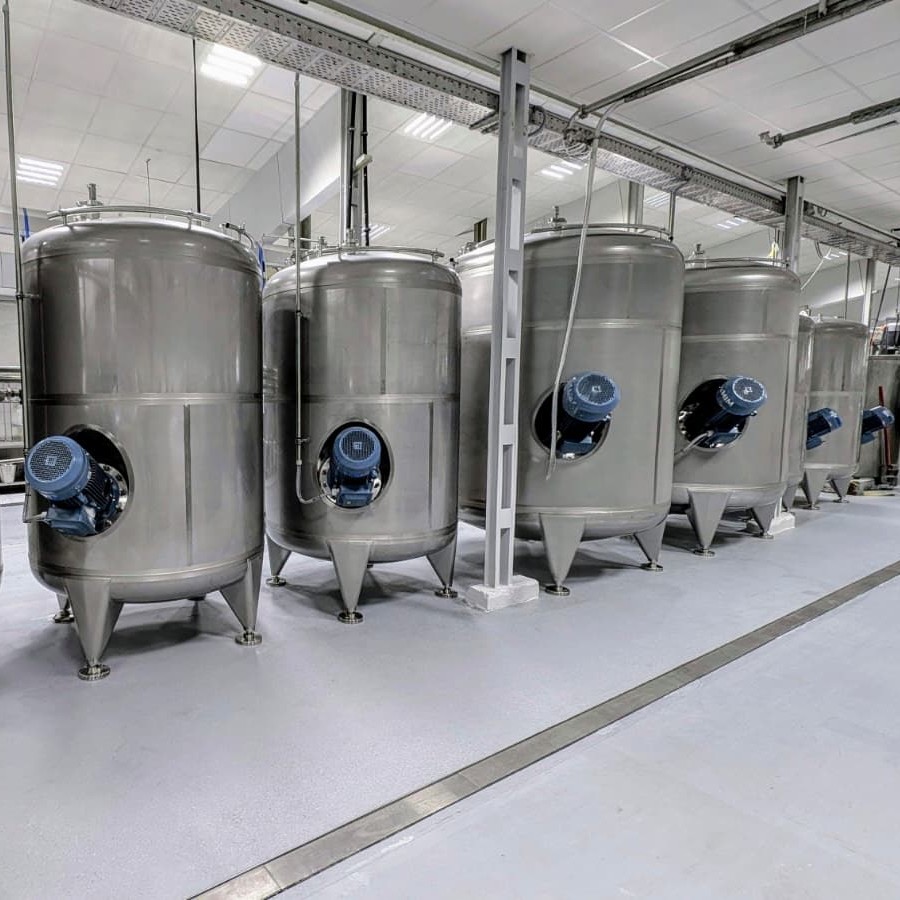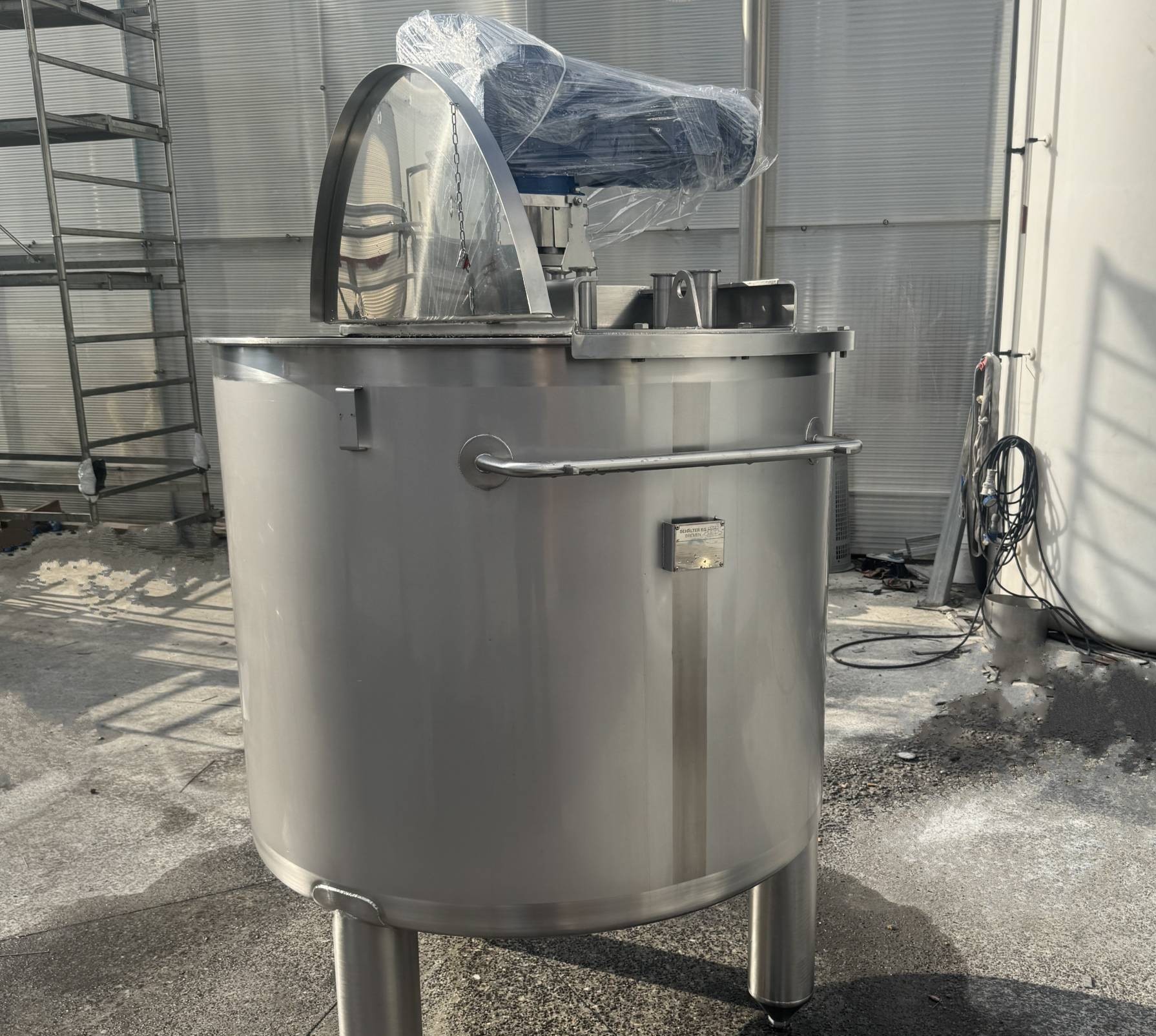Visión general de calidades de acero inoxidable para tanques y recipientes
Los aceros inoxidables han sido parte integral de la construcción de recipientes e instalaciones desde principios del siglo XX. Los grados más comunes utilizados en este campo pertenecen a los grupos acero inoxidable 304 y acero inoxidable 316, que se explican más detalladamente en este artículo.
Las designaciones se remontan a series de pruebas históricas: la “V” se refiere a Versuch (experimento), la “A” a Austenita. El acero inoxidable 304 se compone de cromo y níquel, mientras que el acero inoxidable 316 contiene molibdeno adicional para aumentar la resistencia a la corrosión. Pueden añadirse otros elementos para mejorar propiedades como la ductilidad o la resistencia a la temperatura.
En la práctica, los tanques suelen fabricarse combinando ambos grupos: por ejemplo, acero inoxidable 316 para todas las partes en contacto con el producto y acero inoxidable 304 para elementos estructurales como patas o orejetas de elevación. La razón es sencilla: los grados más aleados son más costosos y deben emplearse específicamente cuando sus propiedades técnicas son necesarias.

Selected stainless steels of the stainless steel 316 group
stainless steel 316 is the upgraded version of stainless steel 304: thanks to around 2% molybdenum addition, corrosion resistance increases significantly—especially against chlorides in seawater or salts. stainless steel 316 also offers clear advantages against other media such as sulfuric acid. In addition, heat resistance is higher than with stainless steel 304.
Commonly used materials
The most widespread materials are 1.4401 and 1.4404. Both deliver high corrosion resistance and are proven in demanding applications such as chemical processing or the food industry. 1.4404 has a slightly lower carbon content and is therefore marginally more resistant and temperature-resistant in specific applications. In everyday use, the properties of both materials are largely identical.
Special variants
A popular subgroup is 1.4571, which additionally contains titanium. This offers advantages when strength at high temperatures is required. Corrosion resistance corresponds to that of 1.4401/1.4404.
1.4435 was developed specifically for medical and pharmaceutical applications. The increased molybdenum and nickel content significantly improves resistance to pitting.
- 1.4429 – very good corrosion resistance
- 1.4439 – highly resistant, even at high chloride concentrations
- 1.4539 – up to 5% molybdenum, extremely corrosion-resistant, significantly more expensive than standard stainless steel 316
Materials of the stainless steel 316 group
| Material No. | International | Special feature |
|---|---|---|
| 1.4401 | AISI 316 | Increased corrosion resistance & forgeability, widely used across demanding industries (pharma, chemical, food) |
| 1.4404 | AISI 316 L | Increased corrosion resistance & forgeability, widely used across demanding industries (pharma, chemical, food) |
| 1.4571 | AISI 316 Ti | Increased corrosion resistance, particularly well suited for high temperatures |
| 1.4435 | AISI 316 L | Higher molybdenum content increases corrosion resistance; used primarily in pharma/medical sectors |
| 1.4429 | AISI 316 LN | Very good corrosion resistance |
| 1.4439 | AISI 317 LMN | Very good corrosion resistance, even at high chloride concentrations |
| 1.4539 | AISI 904 L | For highly corrosive media such as phosphoric or hydrochloric acid, high resistance to pitting and stress corrosion cracking |
Special materials & alloys
For extreme conditions, there are rare special materials such as 1.4529 (Alloy 926) with 6.5% molybdenum—ideal against pitting and crevice corrosion. Under the brand name Hastelloy, highly corrosion-resistant alloys with up to 30% molybdenum are also offered, which are particularly resistant to highly concentrated hydrochloric acids.
Selected stainless steels of the stainless steel 304 group
stainless steel 304 includes all chromium-nickel steels, primarily the material 1.4301. It is the most widely used stainless steel in vessel construction and accounts for over 50% of the total market.
Special subgroups
A rarer variant is 1.4307, which contains slightly less carbon. This results in slightly increased resistance to intergranular corrosion—with virtually identical mechanical properties to 1.4301.
1.4541 is also widespread; it is stabilized by an addition of titanium. This increases corrosion resistance, especially at low concentrations of chlorides, salts, or nitric acid.
Areas of application & limitations
stainless steel 304 is used across industries: in the food industry, the chemical and pharmaceutical industries, construction, and automotive engineering. One disadvantage of 1.4541, however, is that it is not suitable for polishing and is therefore often not used in particularly demanding pharmaceutical applications.
Materials of the stainless steel 304 group
| Material No. | International | Special feature |
|---|---|---|
| 1.4301 | AISI 304 | Very good weldability, good corrosion resistance, the most common stainless steel material across industries |
| 1.4307 | AISI 304 L | Slightly increased corrosion resistance, unchanged mechanical properties |
| 1.4541 | AISI 321 | Increased resistance due to titanium addition as a stabilizer |
¿Desea obtener más información sobre este servicio?
Póngase en contacto con nosotros.


